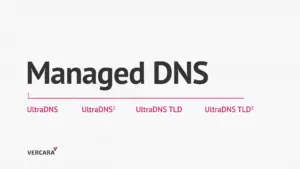UltraDNS TLD is a best-in-class cloud-based Secondary DNS service that ensures fast query responses on behalf of TLD operators, with high availability, regulatory compliance, and excellent observability, with access to complete packet data.
UltraDNS is Vercara’s managed authoritative DNS offering that is used by customers to manage, maintain, and provide fast and reliable global resolution for their authoritative DNS zones. It is used to provide either a primary or secondary DNS resolution with a variety of traffic management and steering options available and is licensed by the number of monthly DNS queries to the customer zones. UltraDNS TLD is used to provide fast and reliable global resolution for queries to Top Level Domain (TLD) nameservers operated on behalf of internet registries. This provides DNS resolution for TLDs such as .BIZ and .BANK, and for ccTLDs such as .CO, and .IN. The UltraDNS TLD service provides secondary resolution and is billed based on the number of domains the customer has.
These actions must occur before they can launch the first attack, send the first beacon, and deliver the first phish before they can exploit any intrusion. Vercara focuses on discovering and mapping this adversary infrastructure and then leverages this knowledge combined with real-time communication pattern analysis to identify and prevent attacks before they happen, thus shifting to a proactive security paradigm.
UltraDNS TLD is built on BIND9 by default.However, we can also deploy it on Knot DNS or NSD.
Yes, we provide all monthly reports to comply with ICANN requirements.
UltraDNS TLD2 is a second DNS resolution global anycast network that works with UltraDNS TLD to provide additional availability and redundancy sufficient to meet the most stringent business continuity and disaster recovery requirements.
UltraDNS TLD² has 18 points of presence (POPs), with geographic and internet topology diversity at the forefront of location selection. POPs are distributed as follows: North Americ 5, Europe: 4, Asi 4, South Americ 2, Afric 1, Middle East: 1, and Oceani 1.
if(test.isValidation()){
//Pause for 2 seconds in validation
test.pause(2000); }
else{
//Pause for 20 seconds during load test
test.pause(20000);
}
If, even after using “isValidation()” to reduce pause time, you’re still running past the two-minute limit, you will need to use the local-validation service. As with a load test, there is no time limit for script execution when using the local validator. Once you have verified the script works as expected on your local machine, upload the script and check the “Bypass Validation” option in the script editor. Finally, it’s advisable that you run a small load test to ensure the script behaves as expected.
UltraDNS TLD² is a network infrastructure that is created by combining two separate networks: the UltraDNS TLD with 29 nodes and the UltraDNS TLD² with 18 nodes. The UltraDNS TLD² network is designed to support the needs of large organizations that require a robust DNS infrastructure to support their online operations. It is important to note that the UltraDNS TLD² network cannot be deployed by itself.
Users that are on your premises are automatically protected when UltraDDR is used as your organization’s recursive DNS solution. For users that are off your premises — or for hybrid scenarios in which users can be on-premises or off-premises at will, your administrators can deploy UltraDDR agents onto your users’ devices to ensure UltraDDR policy is enforced. The UltraDDR Agent is will soon be available for Windows, macOS, iOS, and Android platforms.
The most common error is the converted script expecting 3xx response codes, but seeing 200 instead. This is usually caused by ads, which were originally redirected to register a unique impression. When the converted script attempts to replay the same request, it is caught by the ad server as a duplicate, and the response is altered to prevent additional (false) ad impressions. The fix is as simple as removing the faulty requests or changing the expected response code to what was actually returned. For example:
c.get("http://example.com/ad?req=12345", 301);
Change to:
c.get("http://example.com/ad?req=12345", 200);
The second most common issue is content from third-party domains. The blacklist requests directive from the original RBU script will not be maintained in the Basic script. Our recommendation is to remove any third-party requests from the script. Here is an example of requests that would be removed:
c.get("https://connect.facebook.net/en_US/all.js", 200);
c.get(https://ssl.google-analytics.com/ga.js", 200);
We understand that networks can sometimes experience degradation in today’s interconnected world. That’s why it’s important to consider using redundant networks. UltraDNS TLD2 provides dual DNS resolution global anycast networks that work together to provide higher availability and resilience. With UltraDNS TLD², you can use a single nameserver across both networks for optimal performance or use a separate nameserver implementation in each network in conjunction with UltraDNS TLD’s protocol engine for maximum resilience.
Users that are on your premises are automatically protected when UltraDDR is used as your organization’s recursive DNS solution. For users that are off your premises — or for hybrid scenarios in which users can be on-premises or off-premises at will, your administrators can deploy UltraDDR agents onto your users’ devices to ensure UltraDDR policy is enforced. The UltraDDR Agent is will soon be available for Windows, macOS, iOS, and Android platforms.
The most common error is the converted script expecting 3xx response codes, but seeing 200 instead. This is usually caused by ads, which were originally redirected to register a unique impression. When the converted script attempts to replay the same request, it is caught by the ad server as a duplicate, and the response is altered to prevent additional (false) ad impressions. The fix is as simple as removing the faulty requests or changing the expected response code to what was actually returned. For example:
c.get("http://example.com/ad?req=12345", 301);
Change to:
c.get("http://example.com/ad?req=12345", 200);
The second most common issue is content from third-party domains. The blacklist requests directive from the original RBU script will not be maintained in the Basic script. Our recommendation is to remove any third-party requests from the script. Here is an example of requests that would be removed:
c.get("https://connect.facebook.net/en_US/all.js", 200);
c.get(https://ssl.google-analytics.com/ga.js", 200);



